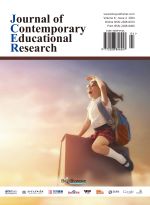Abstract
The construction of early childhood curriculum resources serves as a vital vehicle and precondition for the implementation of collective teaching activities in kindergartens. However, traditional curriculum resources based on graphic language or the linguistic descriptions of early childhood educators often fail to provide children with an immersive experience during collective teaching activities, leading to a lack of initiative and interest in learning. This paper discusses the methods for building a kindergarten curriculum resource library and, based on this foundation, employs virtual reality technology for three-dimensional modeling of the library to enrich the curriculum resources in kindergartens. Furthermore, this paper proposes to train early childhood educators in virtual reality technology to enhance their abilities to operate and utilize virtual reality equipment, which can emphasize the children’s central role in the learning process, better achieve educational goals, and improve teaching outcomes.
References
Koolivand H, Shooreshi MM, Safari-Faramani R, et al., 2024, Comparison of the Effectiveness of Virtual Reality-Based Education and Conventional Teaching Methods in Dental Education: A Systematic Review. BMC Med Educ, 24(1): 1–15.
Lampropoulos G, 2024, Virtual Reality and Gamification in Education: A Systematic Review. Educational technology research and development, 2024(19): 1–95.
Marougkas A, Troussas C, Krouska A, et al., 2024, How Personalized and Effective is Immersive Virtual Reality in Education? A Systematic Literature Review for the Last Decade. Multimedia Tools and Applications, 83(6): 18185–18233.
Ma J, Wang Y, Joshi S, et al., 2024, Using Immersive Virtual Reality Technology to Enhance Nursing Education: A Comparative Pilot Study to Understand Efficacy and Effectiveness. Applied Ergonomics, 2024(115): 104159.
Hu C, Chun X, Chen S, 2016, Application Research on Children’s Indoor Fire Escape Education System Based on Virtual Reality Technology. Journal of System Simulation, 28(4): 934–939.
Zhang Q, 2022, Development and Analysis of Educational Virtual Reality System Using Static Image. Mobile Information Systems, 2022(2022): 1–9.
Sharma RC, Sharma YP, 2021, Designing Virtual Reality Experiences in Education. Learning Technology Technical Committee Bulletin, 21(1): 19–22.
Maskati E, Alkeraiem F, Khalil N, et al., 2021, Using Virtual Reality (VR) in Teaching Students with Dyslexia. International Journal of Emerging Technologies in Learning (IJET), 16(9): 291–305.
Rebollo C, Remolar I, Rossano V, et al., 2022, Multimedia Augmented Reality Game for Learning Math. Multimed Tools and Applications, 2022(81): 14851–14868.
Schnurer R, Dind C, Schalcher S, et al., 2020, Augmenting Printed School Atlases with Thematic 3D Maps. Multimodal Technol Interact, 4(2): 1–23.
Midak LY, Kravets IV, Kuzyshyn OV, et al., 2020, Augmented Reality in Process of Studying Astronomic Concepts in Primary School, Proceedings of the 3rd International Workshop on Augmented Reality in Education (AREdu 2020), May 13, 2020. Kryvyi Rih, Ukraine, 239–250.
Kang S, Shokeen E, Byrne V-L, et al., 2020, ARMath: Augmenting Everyday Life with Math Learning, Proceedings of the 2020 CHI Conference on Human Factors in Computing System. ACM, Honolulu, 1–15.
